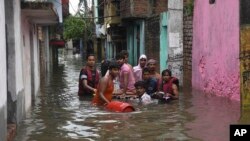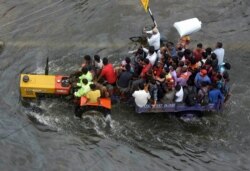This is the time of year when monsoons in India are usually retreating. But torrential rains in the last three days have killed over a hundred people, inundated a major city, disrupted rail and road traffic, and caused widespread havoc in two of the country’s poorest states — Bihar and Uttar Pradesh.
The latest deluge in northern India brought fresh warnings from climate experts that extreme weather events have become more common and pose a major challenge to the country’s crowded and often unplanned cities.
“There is absolutely no doubt now that we have seen a dramatic shift in the rainfall pattern. In a very short duration, you have large rainfall which is overwhelming the entire catchment and the drainage system,” said Chandra Bhushan, deputy director general at the Center for Science and Environment in New Delhi.
Patna, the capital of Bihar, was affected worst by the deadly rains, with much of the city of 2 million people submerged under knee-deep water. With the city resembling a huge lake, some residents said it was the most intense flooding they had seen in nearly five decades.
Teams from the National Disaster Response Force ferried boats on streets to rescue people stranded in their homes. Television images showed an inundated hospital with patients lying in the midst of swirling water in a ward. Among those who had to be rescued was the state’s deputy chief minister Sushil Modi and his family, who were stranded in their waterlogged home. Schools have been shut.
“We have shifted many people to relief camps where the administration is looking after them," Nitish Kumar, chief minister of Bihar, said.
Several cities and towns in neighboring Uttar Pradesh also swirled under floodwaters. In Ballia district, 500 prisoners were shifted out after a jail was submerged. The flood havoc has killed about 90 people in the state mostly due to collapsing homes and walls.
The heavy rains caught authorities by surprise, coming at the tail end of the monsoon season which usually begins in June and starts tapering off by mid-September.
Climate experts say the monsoons have been bringing rains in shorter but more intense spells. Several studies show that heavy rainfalls lasting two to three days are on the rise and triggering floods, especially in unprepared cities.
Last Thursday, unusually heavy rains lashed the western city of Pune in four hours, killing 20 people.
“We have to recognize that we are living in a changing climate, and cities must adapt to it," Bhushan said. "We have to think of resilient infrastructure urgently. For example, the size of the drainage has to increase.”
Experts point out that as Indian cities become home to 1 billion people by 2050, preparation for urban flooding must be prioritized.
The rains are expected to ease in the coming days, according to the India Meteorological Department, which says rains in September have been the most intense in nearly a century.






